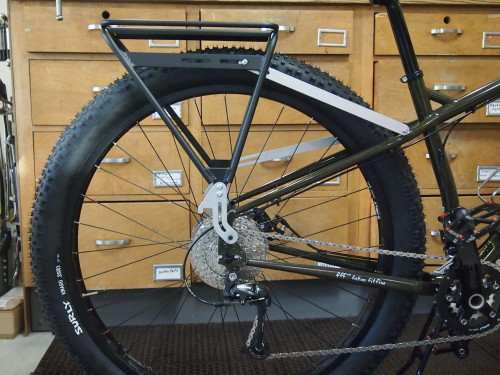
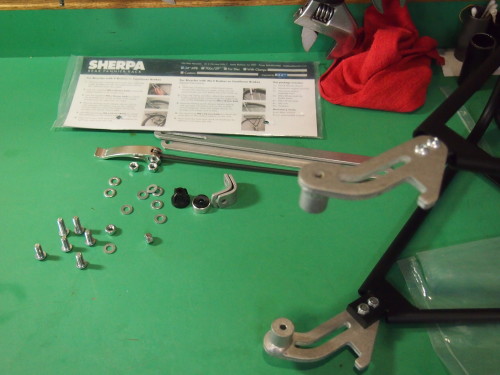
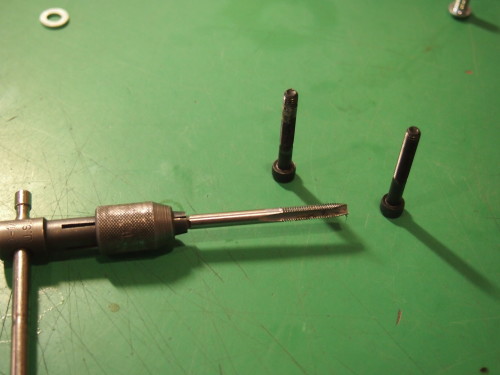
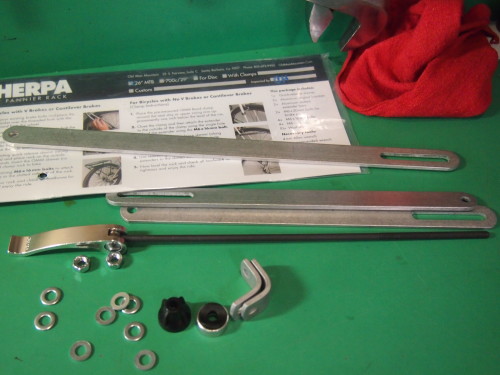
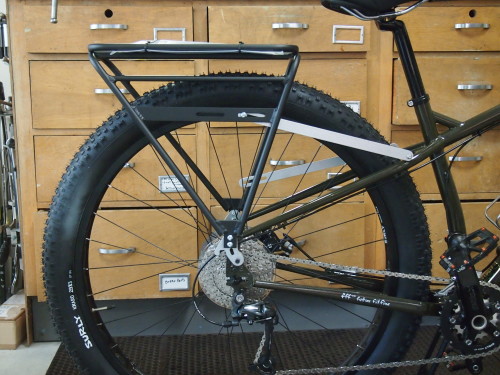
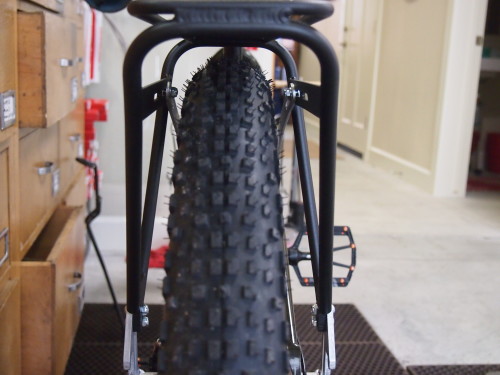
Bags and luggage for the bicycle. There are more ways than one to carry stuff on you bike!






Recently I experienced some discomfiture when I realized the Salsa Wanderlust rear rack would not fit on a Surly Long Haul Trucker. Because the top platform was so long and extended so far forward it actually came into contact with the seat stays, making it impossible to mount the rack so that the top platform was level. Apparently the rack was designed to fit certain Salsa bicycles; those with pronounced top tube slope, short seat stays and lots of seat post showing. This implied a positive short sightedness on the part of Salsa. The expression of my discombobulation to the good folks at Salsa seemed to go unheeded.
More recently we restocked our Salsa Wanderlust racks and brought in one of the new Heavy Duty versions of the rack. Turns out somebody was listening! Both versions of the rack have been redesigned and now fit beautifully on the LHT and Disc Truckers as well as the Cross Check and, I imagine, most other bikes. (as of 12/9/2013 the Salsa site still says-“NOTE: Designed as a rear rack solution for Salsa Fargo and Vaya frames. This rack may not work well with traditional touring frames that feature level toptubes.”)
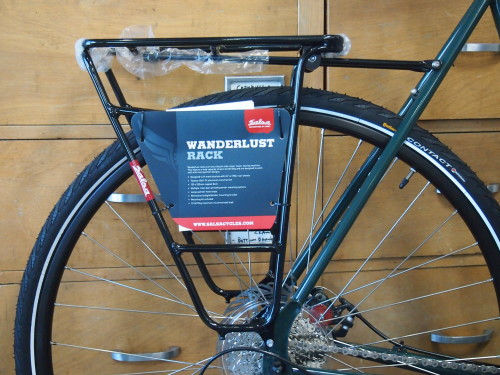
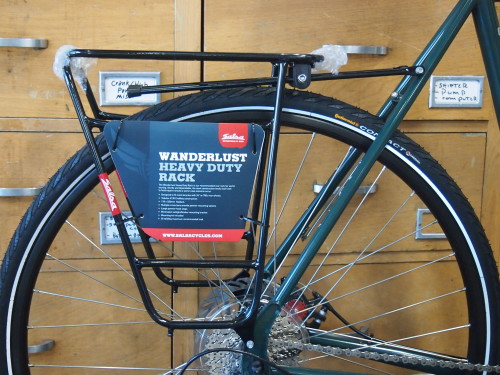
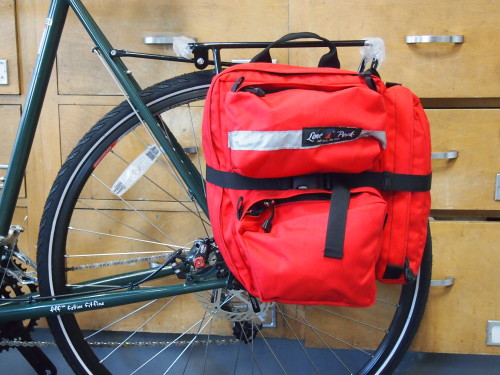
The new Wanderlust racks place the top platform well behind the seat stays, lower than most other racks. The middle pannier carrying rail is lower too. This means you can get your panniers low and out of the way of your heels if you have relatively short chain stays. (touring bikes will have chain stays in the 44 to 46 cm range, measured from the center of the crank to the center of the rear dropouts). The other thought that occurred to me is that there might even still be space for a capacious saddlebag; say the Frost River Caribou Trail for example, in addition to a bag on top of the rack.
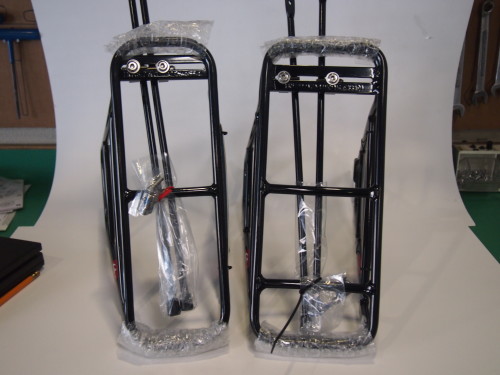
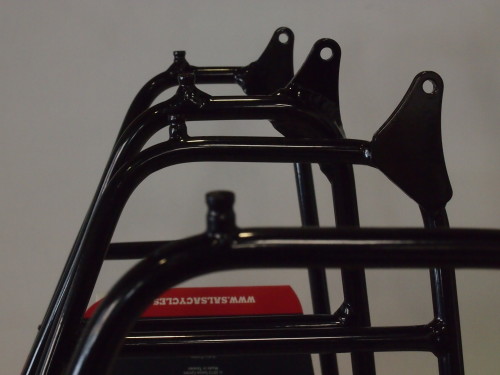
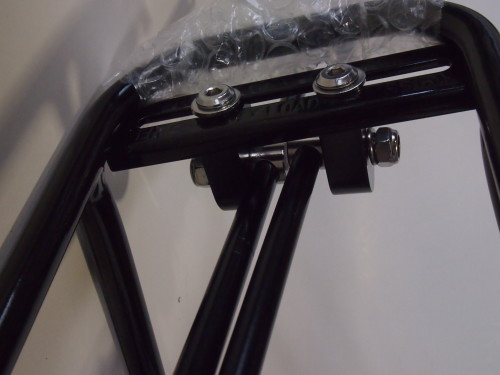
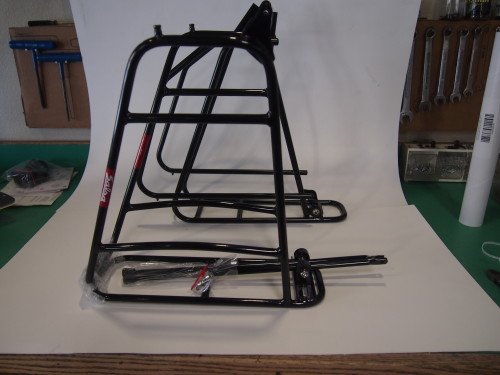
This didn’t start out as comparison between these racks and the Tubus Logo but one is inevitable since the new heavy duty Wanderlust is in the same price range; $140 for the Salsa Wanderlust H.D. and $150 for the Tubus Logo. Both racks are made of steel but the Logo is lighter by almost half a pound or 195 grams. I weighed the Logo at 1 lb. 13 oz. (840 grams). The Logo also has a greater rated load capacity at 40 kilograms or 88 pounds, whereas the H.D Wanderlust has a rated capacity of 25 kilograms or 55 pounds. The standard Wanderlust is made of aluminum and weighs in at 800 grams or 1 lb. 12 oz.; close to the weight of the Tubus Logo, but it has less rated capacity at 15 kilograms or 33 pounds. In fairness it also costs $55 less than the Logo.
These new Salsa racks get the Bike Hermit™ Seal of Approval. For those who have bikes with shorter chain stays but still want to carry a pretty significant load, the Wanderlust H.D. is a good alternative. And the standard Wanderlust is a sturdy, well designed rack that should handle most bicycle touring duties with equanimity.
The Bike Touring News Store has Old Man Mountain racks! Designed and made in Santa Barbara, CA. Old Man Mountain has a rack for almost any bike including full suspension mountain bikes and fat bikes.
Here’s an Adventure Cyclist Story from 2004. It describes the genesis of the company, the owner’s background and some of the philosophy behind the designs.
Please check the offerings in our store and feel free to contact us if you have questions or need a rack you don’t see.
The new shipment of Frost River bike bags arrived at the Bike Touring News Store last week. Frost River may be better known for their canoe packs than for bicycle touring bags but both should be held to the same standard –
“Canoe packs are built for a very specific task (hauling the stuff that will sustain you) in a very specific environment (the Northern Wilderness). In this setting, things like a seam ripping or a sidewall tearing or a strap breaking—little failures that would be an annoyance in everyday life—come with huge consequences.”
-And so it goes for bike touring.
Frost River makes their bags in Duluth Minnesota from materials sourced in the USA.
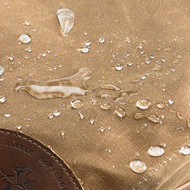
The waxed cotton canvas comes from Fairfield Textiles and is called Martexin Original Wax. The fabric is claimed to have a lifelong resistance to inclement weather as well as being naturally breathable. The hand is not course or stiff even though the canvas is stout. It is evident that the material is impregnated with wax rather than simply coated.
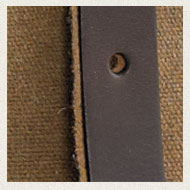
The leather in the straps and reinforcements comes from S.B. Foot Tanning Co. in Red Wing MN. Yes, that Red Wing. I currently have two pairs of Red Wing shoes and it’s sort of neat to know the leather in my bike bag comes from the same source!
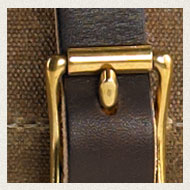
All the buckles, snaps, slides and d-rings are solid brass, not simply plated. And they are big. They might almost appear clunky to some but when fumbling with cold fingers and/or in the dark I think I will appreciate the large size.
The Gunflint Trail is the larger of the two traditional style “transverse” saddlebags from Frost River and it is big. The stated capacity is 20.6 liters but it seems larger…..maybe that doesn’t include the side pockets. And, while this bag could be used without a rack support, it sits very nicely on the Nitto R15 or R14 Top Rack.
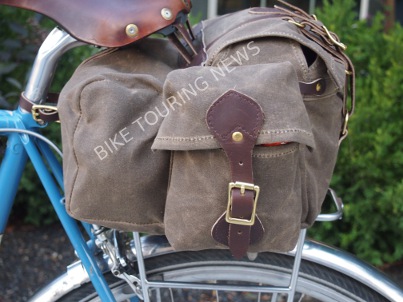
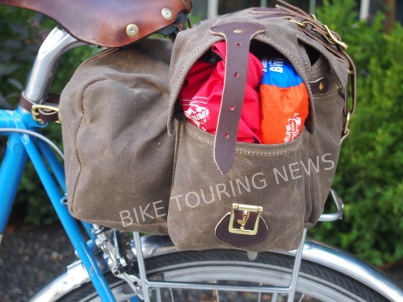

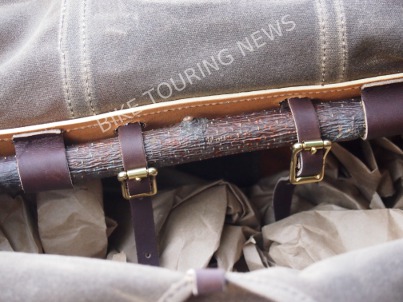
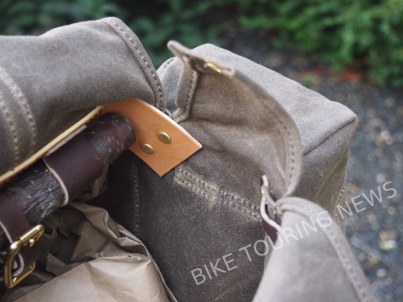
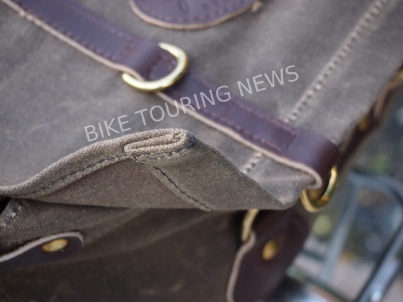

The Caribou Trail bag is an 8.8 liter capacity bag without side pockets. It works as a saddlebag but can also be strapped to the handlebars. A support such as the Nitto R10 rear bag supporter will keep the bag a little proud of the saddle and might prevent any unwanted side to side swaying.

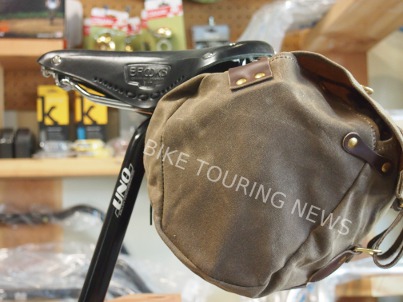
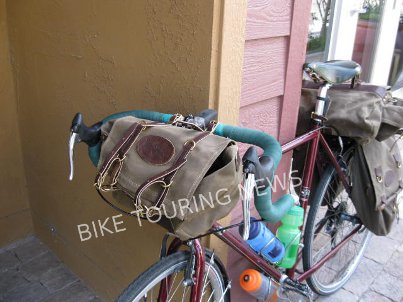
In case you aren’t familiar with Loan Peak Packs – They are a made in the USA, previously based in Salt Lake City but recently relocated to Marysville, Washington. The craftsmanship has always been top notch and the panniers are well worth the price. We have stocked the Mount Superior Pannier since we opened. A large capacity pannier that is perfect for the long distance traveler.
Recently we were discussing the Lone Peak product line with Gary and expressed our interest bringing in a smaller pannier that could work either on the front or on the rear. Gary suggested we consider the Millcreek. Our first set arrived just in time for the Wandering Wheels S24O to Sheep Creek Reservoir. For this trip, the Bike Hermit decided he would take Norm – the Surly Crosscheck with the large Paul Components basket.
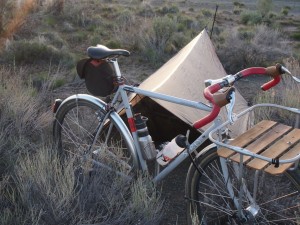
Norm has a custom bag that fits perfectly into the basket and the Bike Hermit was quite pleased with the items he could carry. While he had the stove and his hammock, fitting food and the sleeping bag were a challenge.
Normally, on a S24O I take my Gilles Berthoud front bag and a Zimbale 18 liter but the Millcreeks were calling to me and we wanted to try them out before we offered them in the store. Suffice it to say, we need to order more Millcreeks for the store as I will be hard pressed to relinquish the pair I tried out.
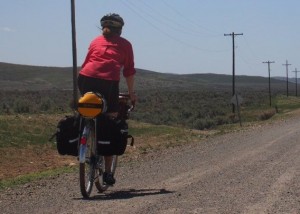
Right off the bat, packing the Millcreek’s are a breeze. The main compartment unzips completely, like a suitcase, making layering and adjusting and FINDING items easy. No more pawing through the pannier or needing to dump half of your items on the ground to find something.

The secondary pocket, also called the large front pocket was a great spot for my camp shoes, camp jacket and assorted small camping necessities. It has a 3/4 zip so again easy to access.

The final “pocket” is mesh, with a zipper so great for damp items, gear you want to use during the day, etc.

I had more than enough room for all my gear (except the tent) – but my hammock would have fit had I chosen to take it. I also packed enough food for the two of us and still had room left over.
Other features that impress me – the panniers stand alone, so nice when taking on and off the bike. The nylon compression strap can be used for extra security by attaching it to the rack but even on dirt and gravel roads the pannier’s didn’t bounce around at all. The locking system was easy to use. A minor issue for me and my Nitto Rack is the bungee with the s-hook that attaches at the bottom. With my rack I just need make sure it stays in place as I pull the pannier up to hook on the top.
The nylon fabric is high quality and very water resistant (tested by riding through a creek) but for those who ride in wet climates Lone Peak makes a rain cover as well.
I know I will be recommending these to many fellow bike travelers.
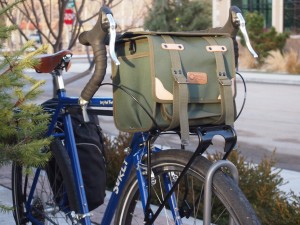
Not precisely “handlebar” bags these Ostrich bags are supported on the platform of a front rack and secured at the top either to the handlebars or by a bracket known as a decaleur. In my opinion the advantages of this style of bag are several:
–The center of gravity is lower than a bag attached to and supported by the handlebars
-The bag is more accessible from the cockpit than panniers.
-An assortment of small pockets make it easy to find the small things you need
-A plastic covered map case is indispensable to the touring cyclist.
-Relatively easy to remove and carry when off the bike. Some come with shoulder straps.
As of this writing their are two sizes of front Ostrich bags (Ostrich also makes a traditional style saddle bag and, I believe, rear panniers); the F-104 and the new, slightly larger F-106.
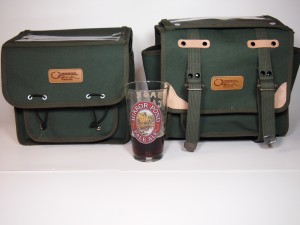
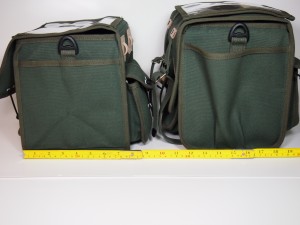
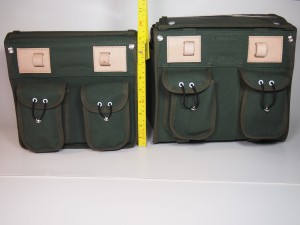
Determining which size bag will work best on a particular machine starts with knowing the distance from the top platform of the rack to the handlebars. The type of stem on the bike -threadless (Aheadset) or threaded (quill)- and, in some cases, the steer tube diameter – 1″ or 1 1/8″- will tell what type of decaleur to use. Gilles Berthoud decaleurs are available in six different configurations, and Velo Orange decaleurs in two. We carry all of them in the Bike Touring News Store and,as always, are here to help demystify.
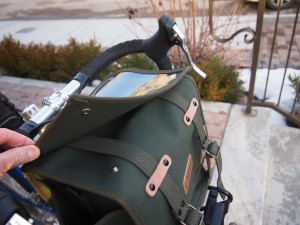
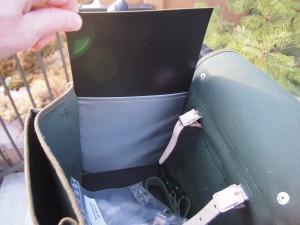
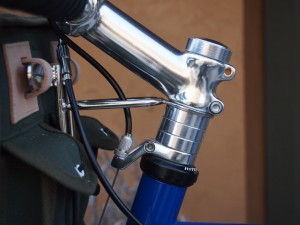
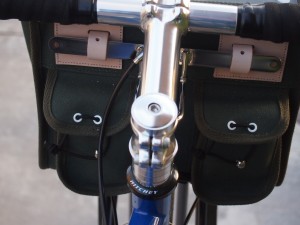
I’ve always liked these bags. I’m a sucker for canvas duck and for the army green color. I like the robust, utilitarian feel and look of these and I think the details are well thought out. The relative voluminous capacities are nice too. When touring it seems as though I’m always looking for the extra pocket or for someplace to lash the rain jacket. These have been unavailable in the US for some time but I’m excited about being able to get them again.
UPDATE 2/19/2013
We will also be carrying the Ostrich Panniers…..
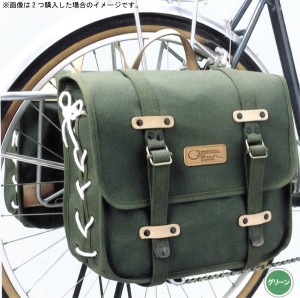
….and the traditional style Ostrich S-2 Saddlebag...
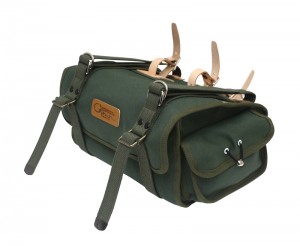
MORE UPDATES! 3/15/2013
We now have the Gilles Berthoud rain covers which work nicely with the Ostrich F-106 and F-104 bags.
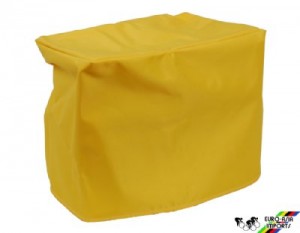
So called “low rider” racks are popular for carrying panniers on the front of the bike. We have already gone over the Nitto Campee rack and the Nitto M-12-2 rack.
Axiom makes the Journey DLX Lowrider and Salsa sells the Down Under rack. Both are made of tubular aluminum.
The Salsa rack is similar to the Tubus Duo in that the top rails sandwich the fork blade and bolt on both sides of it. The only down side is that not all fork blades have a threaded boss on both sides. (The Surly Long Haul Trucker does)
The Down Under rack attaches to the fork dropout eyelets with a welded tab. There are no moving parts and the rack is all one piece which should make it fairly reliable. My only gripe is that there are no “pannier stops” on the top rail and so the panniers have a tendency to slide back and forth but I think some simple after market mods would solve that.
There is a barrel boss welded to the leading edge of both top rails though, ostensibly for the attachment of Salsa’s Minimalist front top rack, but I think they would make ideal light mounts.
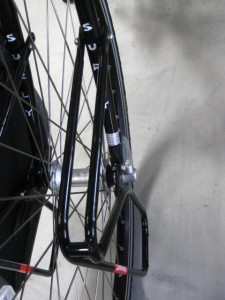
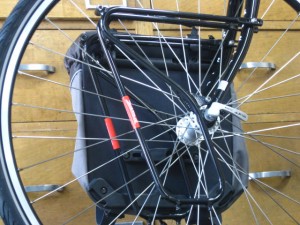
The Axiom Journey DLX Lowrider rack employs a two piece design and comes with a large u-bolt to attach to the fork leg. The two pieces are designed to pivot in order to achieve a fairly level attachment rail for the panniers when used on forks with varying rakes. The good thing about this rack is that mid fork eyelets are not required, in fact it appears that the u-bolt attachment actually is designed to stabilize the rack from twisting. When I bolted the rack to one mid fork eyelet on the Long Haul Trucker I was able to twist the rack with my hands- less than ideal for carrying bags next to the wheels! And even with the pivoting design I was unable to get the top rails completely level with the floor when mounted. On a bike with 26″ wheels and wide profile cantilever brakes, such as the Tektro CR-720, the top rail interferes with the brake caliper….not an issue obviously on a 700c wheel bike or even a 26″ one with disc brakes or narrow profile cantilevers.
Another good feature is the stops on top of the rails to keep the panniers from sliding. This is a serviceable entry level touring rack that will not break the bank.
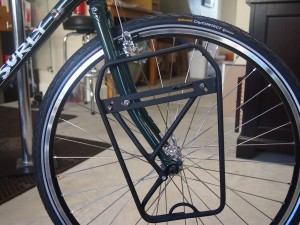
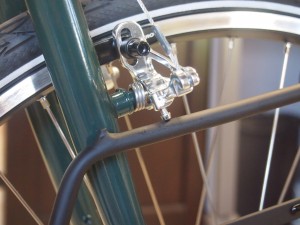
The Bike Hermit likes his front bag because it is easy to reach even when riding and because it has a map case on the top for… maps. A “handlebar” bag, one that attaches only to the handlebar, is not ideal because it affects the steering of the bike too much. One that is supported on a low front rack is better. The Nitto M-12-2 rack is a tubular steel rack made in Tokyo, Japan by the Nitto company. It works on bikes with cantilever brakes and will support a front “rando bag” such as those made by Gilles Berthoud, Acorn or Swift. A person could just strap a dry sack or a tent or zip tie a basket on it too. Since the mounting points are up out of the way, “low-rider” racks and panniers can be used at the same time! The “-2” after M-12 references the two light mount braze-ons- one on either side of the rack.
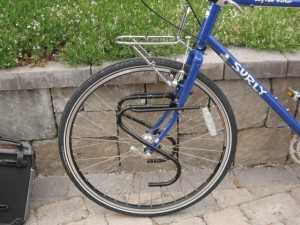
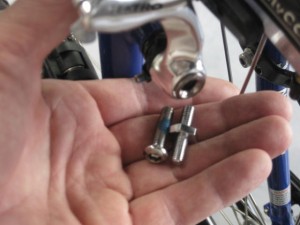
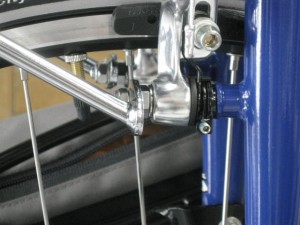
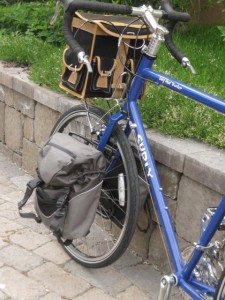
Some minor tweaks may need to be made to get the rack arms or struts to line up with the respective holes and bolts, but these are made of tubular chrome-moly steel which can stand up to a small amount of judicial bending. Just be careful about bending the piece too far….make small incremental adjustments so that you won’t need to bend it back.
Gilles Berthoud makes bicycle products with apparent disregard for costs. The materials and methods and designs are always uncompromising. That is why it is surprising to me that the Gilles Berthoud decaleurs (a bracket made to attach to the bicycle stem and secure a front bag) don’t really work with the Gilles Berthoud rando bags.
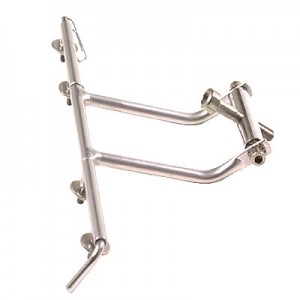
The large bolt replaces the stem bolt and threads into the hole in the short piece of tubing which replaces the stem nut. The arms are bolted on to the short piece of tubing which is threaded at both ends. Then the arms can be rotated to the desired position to line up with the pieces attached to the leather trim piece along the top of the bag so all the pieces can be skewered together. The only problem is, the shape and the length of the arms allow for only a very narrow range of positions; if the arms are parallel to the ground, the bag is pushed too far forward….if the arms are rotated down so the bag can sit closer to the bars the connection point is low, potentially below the point where the pieces need to be attached to the bag. Another problem is that the arms of the decaleur interfere with closing the top flap.
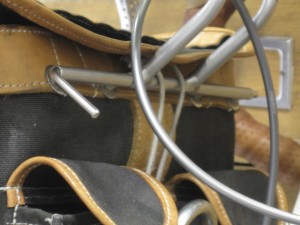
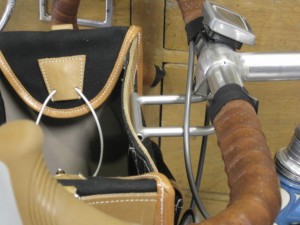
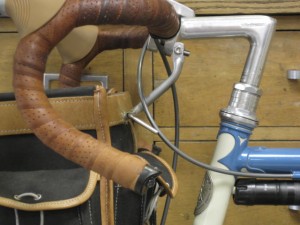
I know someone with access to a machine shop who likes to tinker with bike parts so we imagined a part that would work to replace the stock arms. He did a rough sketch and gave it to his c.a.d. guy who put it into language a machine could understand and out came these:
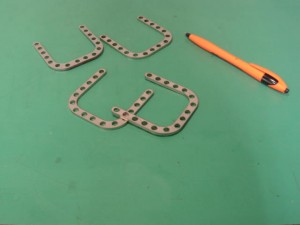
Here’s a comparison of the original bracket arms bolted side by side with the new ones:
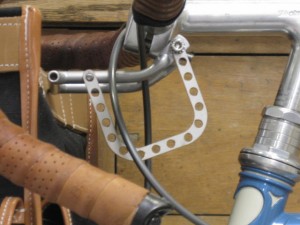
Here are the new brackets in use with a GB25 bag on Sky King’s Bleriot:
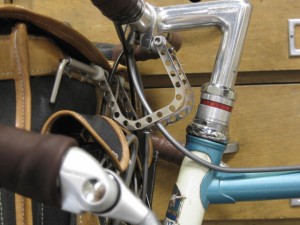
And here are the new brackets on Chief with a GB28 bag:
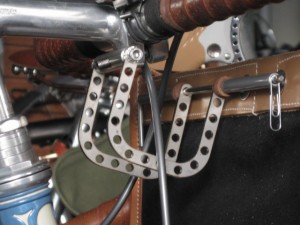
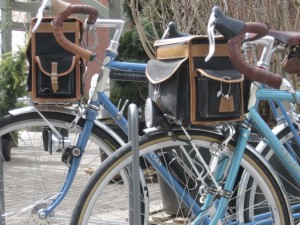
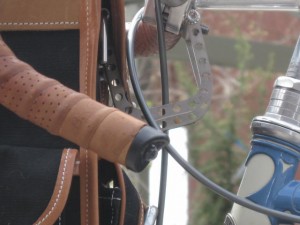
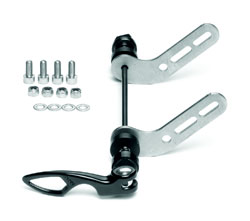
Made for use with Tubus racks, the Tubus Quick Release Adaptermakes it possible to mount a rack securely on a bike without threaded braze on tabs at the dropouts. The package comes with two brackets meant to be attached to the lower two bolt holes on Tubus racks. The supplied skewer is then threaded through the bracket on one side, a shim, (also supplied) the hub axle, and the shim and bracket on the other side and tightened down with the standard cam lever. There are shims provided of two different thicknesses, and the adapter will work on any rear dropout spacing.
Keep in mind that, if your bike doesn’t have eyelets at the dropouts, chances are it wont have eyelets on the seatstays and some sort of clamping arrangement will need to be made there. Tubus makes a stainless steel clamp with a thick and firm cushioning liner, in various sizes, just for this purpose.
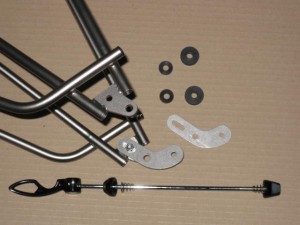
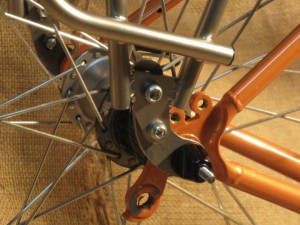
As can be seen in this last photo, the brackets cause the rack to be mounted a little bit farther back than if it were attached to the braze on eyelets. This might also be a good solution for bikes with shorter chainstays when the pannier placement results in heel strike.